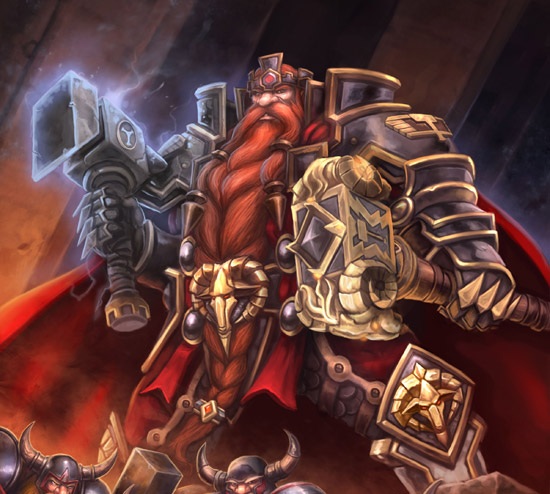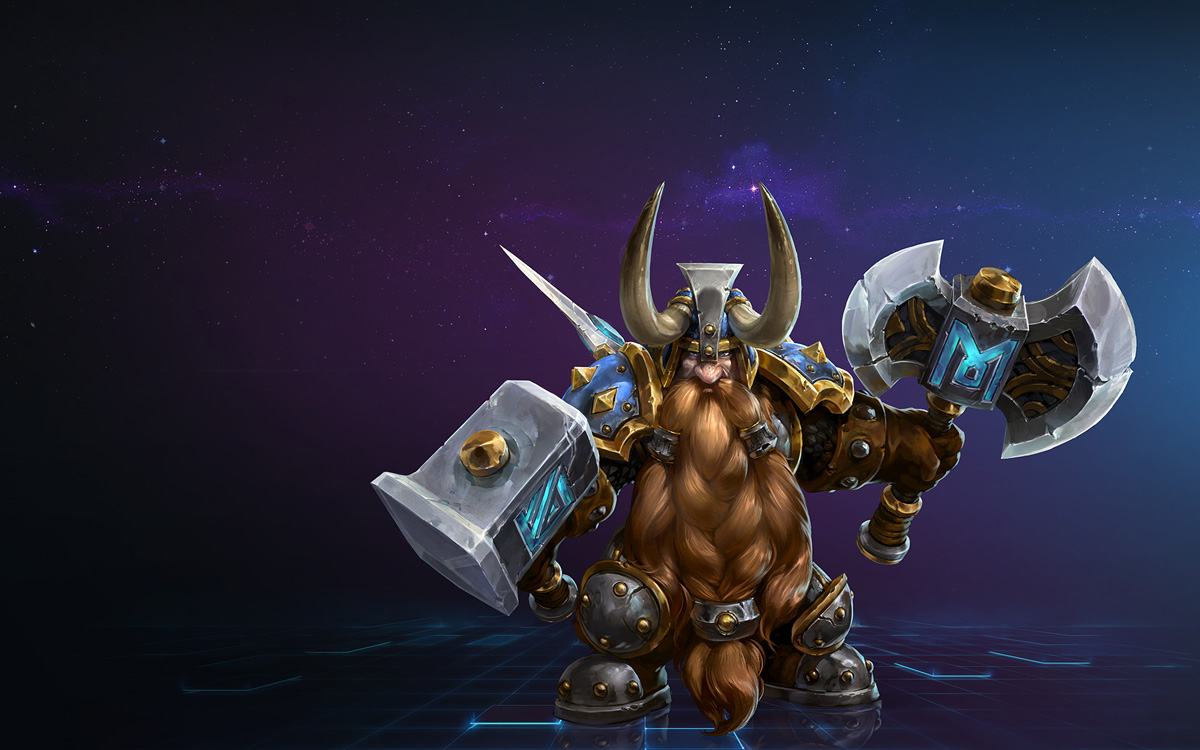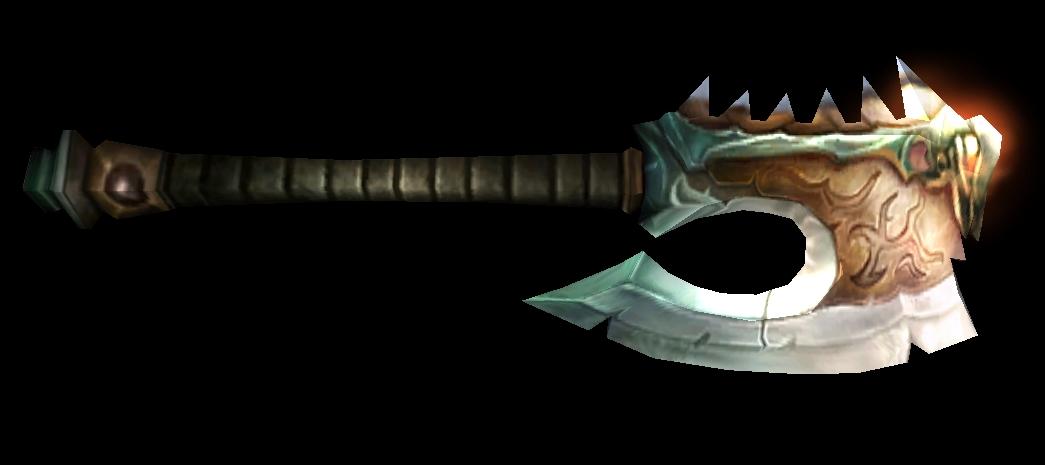Magni Bronzebeard is the (paid) Alliance option for the Warrior Hero, and was the first to be revealed of the “premium” Hero alternates. He is a veteran of Warcraft lore, having survived the second and third wars to come to lead the dwarven mountain kingdom of Ironforge in World of Warcraft.
Magni Bronzebeard, King Under the Mountain
When young, Magni did not think himself capable of being a good king, to the point of wishing that he would be outlived by his father and brothers. His desires met harsh reality when his first brother, Muradin Bronzebeard, was reported dead on Northrend, after accompanying prince Arthas on his quest to defeat the leader of the undead Scourge.
With his other brother, brann-bronzebeard frequently missing during his League of Explorers’ endeavours, being an easily distracted sort, and overall unreliable for anything that didn’t have to do with exploring ancient ruins or studying long-lost artifacts, Magni had to make peace with the fact that he would have to be the best king he could.
Upon learning of Arthas’ hand in his brother’s demise, the King Under the Mountain threw all his sorrow and desire for vengeance into the forging of an enchanted blade for the leader of the Scarlet Crusade, before the crusade revealed itself to be an enemy of undead and non-human alike. This was to be tirion-fordring’s ashbringer.
In the years that followed, Magni had a particular tough time dealing with the Dark Iron Dwarves, an estranged part of his people that had left Ironforge many years before his birth, to found an empire to the south-east, and that had ever since been aggressive, often in open war with their cousins.

The conflict between Ironforge’s “mountain” dwarves and the Dark Irons came to one of its historical peaks as Magni’s only daughter, Moira Bronzebeard, was kidnapped and taken to the Dark Iron emperor-thaurissan. Magni then commissioned a party of adventurers to assassinate the Emperor and rescue his daughter.
This became one of World of Warcraft’s best known end-game subplots and is notable mostly because of its twist ending: Moira ends up revealing that she is in love with her captor, emperor-thaurissan and that she carries his son. She then refuses to go back to his father – whom she views as not respecting her leadership capabilities – and remains as Queen to the Dark Iron Dwarves.
This is a relevant plot in World of Warcraft history for a couple of reasons. First, it is the first step toward a possible reunification of the dwarven clans.
Secondly, it is one of the earliest and most even-handed references to gender politics in video games.
In recent years, the topic has become a bit of a sore point for many video game enthusiasts due to heavy-handed commentary both in games and games press, but at the time when the quest was introduced in World of Warcraft, it was topic that had rarely, if ever, been breached.
Magni’s disdain for the idea of women in positions of power is well-documented. While it was obvious that he had always intended for his daughter to inherit the throne, he was vocal about his disappointment in having no male heir, believing that it took a man to properly rule the dwarven kingdom.

Moira herself later stated that one of the main reasons for her choosing to willingly be with emperor-thaurissan was that he, unlike her father, respected her and her political ability. The regret of having lost his daughter due to his belief that women had no place in government stung the king greatly, and he proceeded to slowly enact changes in the ruling body of Ironforge so as to promote a greater participation of women in civic duty.
Many years passed until Magni would once again be part of major events in Warcraft lore.
After a brief appearance during the Wrath of the Lich King storyline, where he reunited with his brother Muradin, who was then revealed not to have died as initially reported, but been severely wounded and amnesiac, the King Under the Mountain met his untimely end at the beginning of the cataclysm.
Believing to have discovered the secrets behind ancient stone tablets his brother brann-bronzebeard found at Ulduar, Magni decided that he could use their ancient power to commune with the mountain itself and protect his people from deathwing’s forces.
Alas, for reasons that have never been made entirely clear, the incantation fails, and Magni is turned into diamond. He is currently presumed dead, his crystalline body a grim monument that can be witnessed by World of Warcraft players that venture deep into Ironforge. Of course, the possibility remains that he might be saved from the curse in a future plotline.
He was to be succeeded by his daughter, Moira Bronzebeard, but the differences between the dwarven clans were deemed to be too great to be dissolved by a common ruler, so Moira accepted to represent the Dark Irons in Ironforge, and share power with her uncle Muradin, representing the mountain dwarves of the Khaz Modan region, and Falstad Wildhammer, representative of the mountain dwarves of the Wildhammer clan, from the far-away lands of Aerie Peaks. Together they form the ruling Council of the Three Hammers.
It is widely accepted that Magni’s grandson will inherit the throne once he comes of age, hopefully completing the reunification of the clans.

The Warrior’s Weapons
While equipment has historically been an important matter for all of World of Warcraft’s nine character classes, weapons are especially relevant to the Warrior class (one of the classe’s specializations is even called “Arms”).
So, there are some weapons that, while never having been exclusive to the warrior, have been strongly associated with the class, and as such have made the transition to Hearthstone as Warrior Hero cards.
First among these is the endearingly (or derisively, depending on whom you ask) named “Fiery Win Axe”, fiery-war-axe, the card that every Warrior seems to have in his or her starting hand.
This card is historically remarkable only for actually being extremely rare in World of Warcraft, one of the few epic quality items that could be equipped at relatively low levels, and as such, quickly obsolete as the player rose in level. As it were, it became mostly a status symbol: a luxury only very rich players could afford.
The arcanite-reaper is a totally different matter. While not epic, it was an expensive craftable item that became heavily favoured by warriors that reached the maximum level and wished to pursue the path of the damage-dealer instead of becoming tanks. It was especially valued by players that wanted to participate in Player Versus Player combat and events.
The Reaper became enough of a cult item in classic World of Warcraft that new versions have been made available in later expansions, with special emphasis given to heirloom-type items, that grow in power with the players and as such can be used while leveling a character from scratch to maximum level.

Finally, we come to the legendary gorehowl. There is little to add to the history of grommash-hellscream’s weapon over what has already been told in the previous warrior lore article and the Shaman Lore article.
Suffice it to say, it was coveted by players for a long time, and many were dismayed to find out that, when it was finally made available for players to get by killing one of the games more challenging – at the time – bosses, it was merely of epic quality, instead of the Legendary category that has come to be expected for weapons wielded by historical characters.
While it seems a small distinction in retrospect, at the time it felt like a slap in the face of grommash-hellscream fans in particular.
Charge!
While not a great card in the grand scheme of things, charge is worth mentioning because it was one of the most unique abilities of the early World of Warcraft warrior.
Basically allowing the warrior to close the distance between him and his opponent in an instant, as well as dealing a bit of damage, the red streak of speed crossing the battlefield soon became one of the warrior’s trademarks.
Execute
The warrior was, once more, the pioneering class when it came to a whole new kind of situational attacks. While in today’s World of Warcraft, many classes have what is now known as an “execute” ability ( as is the case with the paladin’s hammer-of-wrath ) the warrior had the original execute.
The original concept was that of a spell that dealt massive amounts of damage to near-death ( less than 20% HP ) enemies, a novel idea at the time, used as a way to make fights develop different rhythms as they dragged on.
The Hearthstone card captures this concept neatly, providing high utility removal at a low cost, so long as the minion in question is damaged.

Battle Rage
This one represents yet another elegant translation of a classic World of Warcraft mechanic into the field of card games. In the MMO, warriors don’t use mana, as most classes do. Their resource is “rage”, that they use to power several of their abilities. Rage is generated by dishing out and receiving punishment.
Instead of coming up with a way to integrate a totally different resource into Hearthstone’s Warrior, Blizzard opted for the more practical route of giving warriors mana just like all other classes, and turning their World of Warcraft rage-generating abilities into sources of card draw. battle-rage is probably the best such example.
Shield Block
Other than rage generation, the concept of “living to fight some more”, or resilience, also seems to have some correlation with draw mechanics in Hearthstone. The rogue’s sprint is a perfect example – running away to regroup, recover your breath, and come up with a plan: a metaphor for increased resources.
Basically, having cards means having more options, and a lot of warrior tank gameplay is predicated on the skill to successfully use abilities like shield-block to survive particularly tough periods of a fight.
Even though neither Garrosh nor Magni were ever known to use shields…
The King of Stormwind
In retrospect, it’s a bit odd that varian-wrynn is the card and Magni Bronzebeard is the alternate hero. The King of Stormwind is Garrosh’s counterpart in many more ways.
The uncontested leader of the Alliance, and the Priest Hero Anduin’s father, varian-wrynn was a prisoner of onyxia and nefarian’s Black Dragonflight for a long time, as the dragon siblings sought to manipulate the kingdoms of man through trickery and deceit.
Shortly after the children of deathwing were defeated and the king was freed, bolvar-fordragon, his longtime friend and the custodian of his son, met his end on the icy shores of Northrend, victim of a treasonous plot brought about by infighting within sylvanas-windrunner’s forces. varian-wrynn blamed the Horde, and would have declared all-out war against Thrall and Garrosh if not for Jaina Proudmoore’s intervention.
But the tensions kept mounting as the cataclysm struck, and with the departure of the more diplomatic-mind Thrall from the Horde, and Garrosh’s aggressive rule – culminating with the detonation of the Mana-Bomb that wiped out Theramore – varian-wrynn was on the path to becoming the Alliance’s version of Garrosh.
Except for the influence of Anduin Wrynn, his son. Having been, by luck and fate, stranded in Pandaria just as Garrosh started to try to seize it for the Horde, the Priest Hero took the path of peace and diplomacy, befriending and seeking to understand the locals.
When varian-wrynn saw the great respect his young son had managed to garner among the leaders and living deities of Pandaria, he was both proud, humbled and inspired, and decided to relent in his violent ways.
Ultimately, as Garrosh was defeated, he choose to treat him as a criminal, and left the rest of the Horde be, not blaming them for the rogue Warchief’s actions – much to the displeasure of Jaina, who since the destruction of Theramore had wanted nothing more than to see the Horde erased from Azeroth.
After having little involvement with the Alliance’s extra-dimensional campaign into the past of Draenor, varian-wrynn seems set to take to the main stage once more, as he is charged with leading the Alliance’s combined forces against the new invasion of the Burning Legion.
varian-wrynn’s mechanics as a card are simple and accurate: he is an unmitigated badass, as can be seen in the latest trailer for World of Warcraft’s next expansion, hence the 7/7 body, and has at his disposal full command of the forces of the Alliance, hence the card draw and possibly free drops.
The Warrior’s Future
And this concludes our foray into the Warrior’s history and lore.
While the class seems to be in a good spot, it does seem to rely overly on the defensive play style favoured by his Hero Power, a bit incongruously with the World of Warcraft class, as WoW warriors can just as easily have a very offensive and aggressive play style.
It would be interesting to see Blizzard find a way to explore this facet of the Warrior – possibly using some sort of Hero Power changer in the mould of the Priest’s shadowform or auchenai-soul-priest.
What do you think? What would you like to see? Let me know in the comments!





Published: Dec 9, 2015 10:20 am